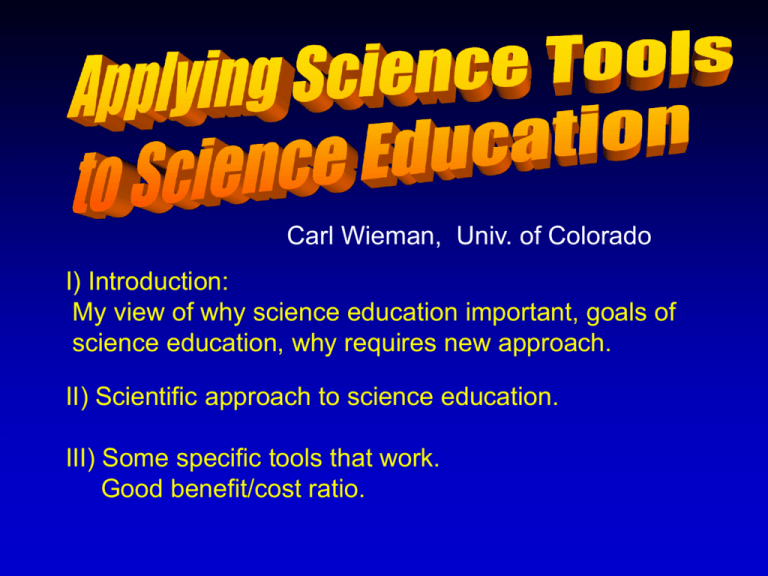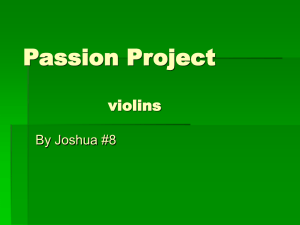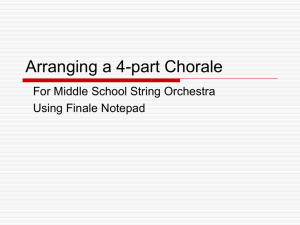O) Why science education important today?
advertisement

Carl Wieman, Univ. of Colorado I) Introduction: My view of why science education important, goals of science education, why requires new approach. II) Scientific approach to science education. III) Some specific tools that work. Good benefit/cost ratio. O) Why science education important today? Past: ~ 2000 B.C. to 1950 A. D. Train replacements. + few decades- filtering of engineers and premeds. Now. 1. Enlightened self-interest-- people will not fund science unless understand and appreciate. 2. It’s the economy stupid. Highly technical economy, needs large technical workforce to maintain and grow. 3. Survival of world. Power to really screw things up! Policy decisions made by the Public. Need a LOT more technically and scientifically literate to decide wisely. To fill this need we must: • Educate large diverse fraction of population. • Science education effective and relevant. "Form" not "reform" science education! Never done any place, any time. How? Step 1. Goal of science education for individual learner? The primary educational goal. Transform “novice” attitudes and problem solving approaches into “expert”. Think about science like a scientist. COGNITION AND INSTRUCTION (physics), David Hammer Expert Novice Beliefs about structure Coherence Formulas Beliefs about content Concepts By Authority Beliefs about learning Pieces Independent (experiment) Problem-Solving Behavior Problem-solving independent of concepts. Manipulates equations. Backward-looking means-ends techniques. Spends more time! Gets much more frustrated! Conceptual knowledge impacts problem-solving. Performs qualitative analysis. Uses forward-looking concept-based strategies. More time setting up solution, less time total. More satisfaction. think about science like a scientist How to get there? Use tools of science to teach science! Tools of science for science education. 1. Well defined measurable goals (learning), measure results. 2. Gather unbiased data (on student learning). Conclusions principles practices using data not hopes or anecdotes or philosophy. 3. Know initial conditions. Take into account imperfectly controlled variables. (student variation) 4. Utilize new technology effectively. 5. Learn from past research. Disseminate results rapidly, duplicate and build on success. Revealing results from education research. 1. Instructors in science courses usually poor at knowing what students are (and are not) learning. 2. Very little information transfer in traditional lecture course. 3. Thinking is not a spectator sport. Need to do it to learn how. 4. If memorization of content and problem-solving recipes will do well on exam, that is what students will learn. 5. People do not learn something if they see no reason for learning it. Telling them why later is too late. 6. Most physics courses move students away from expert toward novice attitudes and problem solving! Comparison of traditional lecture (red) vs interactive engagement (green) in intro physics. R. Hake Fraction of unknown concepts learned (FCI). 14 classes trad. 48 classes inter. engagement Science education today- like science of Galileo’s day. Radical idea of measurement based science. •New approach. •Showed old ideas wrong. •Led to explosion of progress. improved measurement technology theory improved insight measurement Vision of science education tomorrow•Research-based approach. •Every class rigorous measurement of student learning. •Measurement drives practice-- continual improvement. •Technology for large scale measurement and feedback. •Dissemination of results, share, copy, improve. Enabling developments : •Research in education-- basic principles & practices learning and assessment of learning. (How People Learn, Learning and Understanding (NAS),…) •Technology-- practical widespread measurement of learning, feedback, handling lots of data. Vision of science education tomorrow•Research-based approach. •Every class rigorous measurement of student learning. •Measurement drives practice-- continual improvement. •Technology for large scale measurement and feedback. •Dissemination of results, share, copy, improve. Ultimate link between research and teaching. Using scientific approach to educate students to think like scientists! sounds good but … Implementation still lagging. •“Development” of R & D needed. (from learning research to efficient tools for Physics 101). •Human element (Unscientific scientists.) A. Common unscientific mistakes in science teaching. 1. Follow tradition-- just superstition as to what is “best”. Hard to avoid! (examples here) 2. Conclusions as to effectiveness based on hopes and anecdotes. 3. Extrapolating to students what worked for them. Curriculum: “How Sci.& can students Eng.’s “What learnstudents this?” should know…” 4. "Cop-out". Students not as prepared or motivated as us. …. Human factors 2. Remember what it is like--CEW history Applying research-based approaches to intro classes ~ 6 yrs. • Group projects, homework, and/or presentations • interactive lecture demonstrations/experiments • context reach problems and presentation (“real world”) • various forms of feedback and assessment • technology • learning goals Lots of work, “limited” indications of success: “I learned a whole lot in this class, but Prof. Wieman should be fired and I should get my tuition back. I had to learn it all myself, he never taught us anything.” Experience, better understanding of principles, better goals and measures, more work improved success (& less whining) Finally success very evident! Some examples of stuff that does work. 1. Cheap and non-time-consuming to use. 2. Dramatic quantitative evidence. 1. Individual electronic response system. 2. Interactive simulations. IR clickers (individual electronic feedback system). (cost small: ~$2 K, this room + $29 per student) Impacts: 1. Students engaged. 2. Feedback to instructor. 3. Feedback to students-Much higher retention of ideas & information. Ways in which we use: many types of questions. 1. Start of class quizzes on reading. 2. Quick surveys on backgrounds, course issues, … 3. Students predict results for all demonstrations. 4. Check understanding of material covered. 5. Reveal prevailing misconception to confront/get attention leading into coverage of material. assigned seats and consensus groups Does it work? 1. Student assessment. 60 Usefulness of lecture to your learning 50 40 30 20 10 0 great deal fair amount some a little none line--1010 (fall ‘01): lots of demos, colored cards feedback, no groups column--1020 (spr ’03): used clickers, assigned seats and groups 2. Measures of retention of information from lecture, with and without clicker based questions. Explaining about sound and how a violin works. I show class a violin and tell them that the strings cannot move enough air to produce much sound, so actually the sound comes from the wood in the back. Point inside violin to show how there is a sound post so strings can move the bridge and sound post causes back of violin to move and make sound. 15 minutes later in the lecture I asked students a question the sound they hear from a violin is produced by a. mostly by strings, b. mostly by wood in back, c. both equally, d. none of the above. What fraction gave the correct answer? a. 0%, b. 10 %, c. 30%, d. 70%, e. 90% b. 10% lightening rods ---------------------------------------------------------------------- +++++++++++++++ +++ Lightening rods a. attract lightening to tip, prevent from hitting rest of building. b. prevent lightening from occurring. c. make it strike somewhere else. d. don’t actually do anything, are superstition. first asked 10% correct. 2. days later, asked again. 88% correct (consistent with 100%) + + + + + + + + + + + ++ + + + + + + + + + + + + + + + + + + + + + + + + + + ++ + + + + + + + + + + + + + + + Cheap (to you!) and effective technology II. Online interactive simulations. Physics2000 BEC applets. Physics dept. colloq. to 4th graders! Physics Education Technology Project (PhET) Wide range of topics, extensive testing (in process), guided discovery units (in process), Carl Wieman Noah Finkelstein Ron LeMaster Sam Reid Wendy Adams Krista Beck Kathy Perkins Mike Dubson http://www.colorado.edu/physics/phet/ supported by: The Kavli Institute, NSF, Univ. of Col., and A. Nobel Summary: Tools of science can revolutionize education just as they did science. Will take time and attention to fact "thinking scientifically" not natural human activity. Need good tools, convincing data. http://www.colorado.edu/physics/phet/ III. Specific science based approaches that have “worked” for me. (~ all adapted from ideas in res. lit.-- ed., psych., advertising) What data indicates “worked”? Intro algebra-based physics for nonscientists. Traditionally unpopular, hard to teach. With entire package: •Enrollment x 2-3 (200 first term, 55 second) •Attendance x ~2 •Time on homework x 1.5-2 •Scores on exam problems up ~ 1sigma (~2 grades) • Dramatic change in student attitudes about physics and classroom atmosphere. Not class specific. Expect similar effects for any intro courses and many more advanced classes. Entire package (existence proof, don’t duplicate!) *1. Specific measurable learning goals. 2. Content: start with phenomena & technology then go to general physics concepts. Handles relevance, connection with real world. 3. Questionnaires on background and attitudes, before, during, after. Mostly use SALG free online system. 4. Long, hard, homework sets, connect to real world, pass “why should anyone care” test, substantial essay part. 5. Facilitate and encourage collaboration on homework. (& listen in) *6. Interactive Java programs-- visual conceptual models. *7. In class electronic feedback system. 3 person response groups. 8. Interactive lecture demos, predictions, real data. 9. Required to read text before class. 10. System for ongoing feedback on items of confusion, interest, help or hinder learning. 11. Powerpoint with fancy graphics- available on web. 12. Extensive class website. Lecture notes, assignments, solutions, example problems, derivations, …






